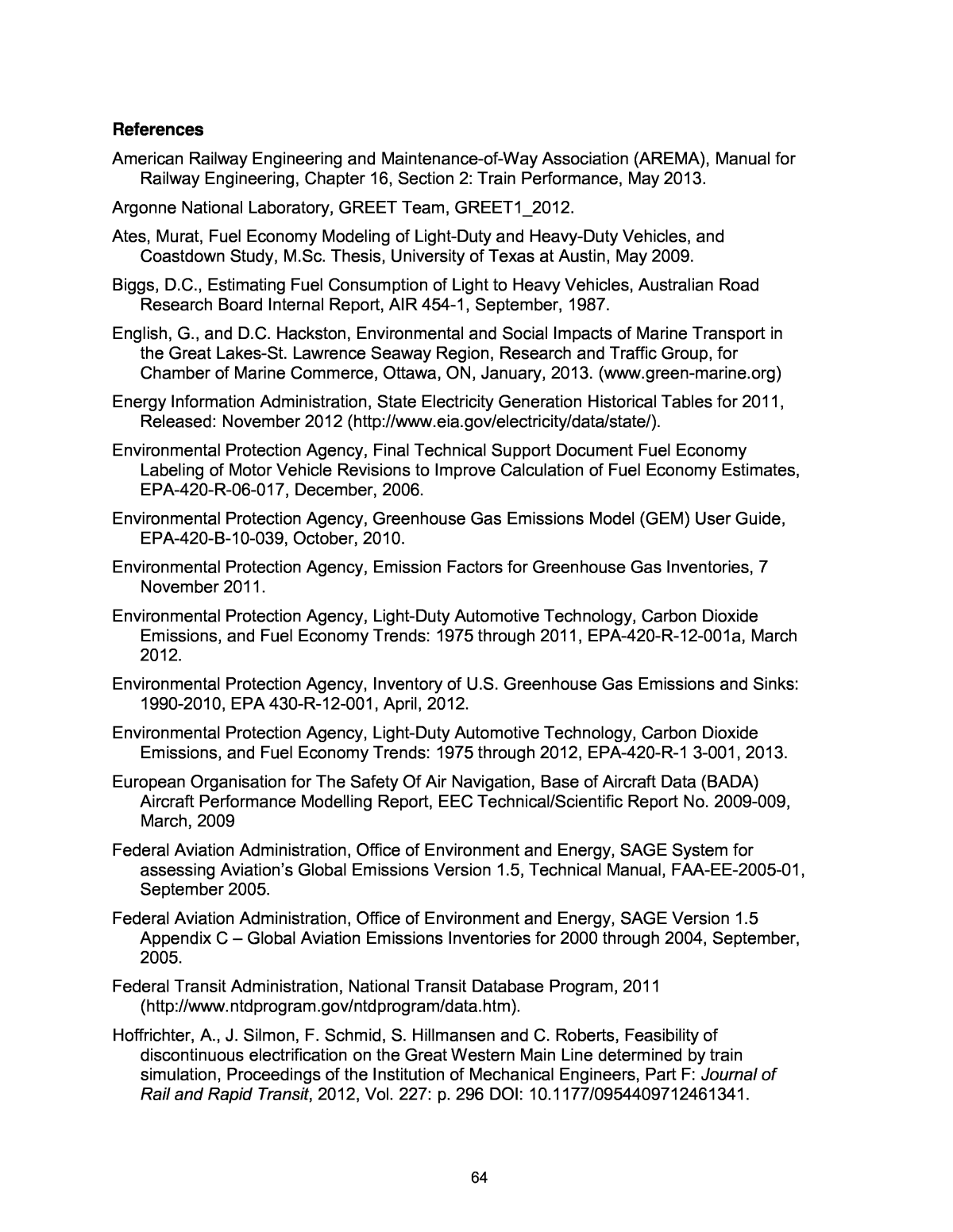

Below is the uncorrected machine-read text of this chapter, intended to provide our own search engines and external engines with highly rich, chapter-representative searchable text of each book. Because it is UNCORRECTED material, please consider the following text as a useful but insufficient proxy for the authoritative book pages.
References American Railway Engineering and Maintenance-of-Way Association (AREMA), Manual for Railway Engineering, Chapter 16, Section 2: Train Performance, May 2013. Argonne National Laboratory, GREET Team, GREET1_2012. Ates, Murat, Fuel Economy Modeling of Light-Duty and Heavy-Duty Vehicles, and Coastdown Study, M.Sc. Thesis, University of Texas at Austin, May 2009. Biggs, D.C., Estimating Fuel Consumption of Light to Heavy Vehicles, Australian Road Research Board Internal Report, AIR 454-1, September, 1987. English, G., and D.C. Hackston, Environmental and Social Impacts of Marine Transport in the Great Lakes-St. Lawrence Seaway Region, Research and Traffic Group, for Chamber of Marine Commerce, Ottawa, ON, January, 2013. (www.green-marine.org) Energy Information Administration, State Electricity Generation Historical Tables for 2011, Released: November 2012 (http://www.eia.gov/electricity/data/state/). Environmental Protection Agency, Final Technical Support Document Fuel Economy Labeling of Motor Vehicle Revisions to Improve Calculation of Fuel Economy Estimates, EPA-420-R-06-017, December, 2006. Environmental Protection Agency, Greenhouse Gas Emissions Model (GEM) User Guide, EPA-420-B-10-039, October, 2010. Environmental Protection Agency, Emission Factors for Greenhouse Gas Inventories, 7 November 2011. Environmental Protection Agency, Light-Duty Automotive Technology, Carbon Dioxide Emissions, and Fuel Economy Trends: 1975 through 2011, EPA-420-R-12-001a, March 2012. Environmental Protection Agency, Inventory of U.S. Greenhouse Gas Emissions and Sinks: 1990-2010, EPA 430-R-12-001, April, 2012. Environmental Protection Agency, Light-Duty Automotive Technology, Carbon Dioxide Emissions, and Fuel Economy Trends: 1975 through 2012, EPA-420-R-1 3-001, 2013. European Organisation for The Safety Of Air Navigation, Base of Aircraft Data (BADA) Aircraft Performance Modelling Report, EEC Technical/Scientific Report No. 2009-009, March, 2009 Federal Aviation Administration, Office of Environment and Energy, SAGE System for assessing Aviationâs Global Emissions Version 1.5, Technical Manual, FAA-EE-2005-01, September 2005. Federal Aviation Administration, Office of Environment and Energy, SAGE Version 1.5 Appendix C â Global Aviation Emissions Inventories for 2000 through 2004, September, 2005. Federal Transit Administration, National Transit Database Program, 2011 (http://www.ntdprogram.gov/ntdprogram/data.htm). Hoffrichter, A., J. Silmon, F. Schmid, S. Hillmansen and C. Roberts, Feasibility of discontinuous electrification on the Great Western Main Line determined by train simulation, Proceedings of the Institution of Mechanical Engineers, Part F: Journal of Rail and Rapid Transit, 2012, Vol. 227: p. 296 DOI: 10.1177/0954409712461341. 64
Hofman, T., M. Steinbuch, R.M. van Druten and A.F.A. Serrarens, Hybrid Component Specification Optimisation For A Medium-Duty Hybrid Electric Truck, Int. J. Heavy Vehicle Systems, Vol. 15, Nos. 2/3/4, 2008. Intergovernmental Panel on Climate Change, Special Report Aviation and the Global Atmosphere, 1999, and see separate Summary for Policymakers. John Dunham & Associates, Motorcoach Census 2013, for the American Bus Association Foundation, 2013. (http://www.buses.org/Files/Foundation/Census2013.pdf) Lindgreen, E. and S.C. Sorenson, Driving Resistance from Railroad Trains, European Commission Report MEK-ET 2005-03, February 2005. Lukaszewicz, P., Running resistance - results and analysis of full-scale tests with passenger and freight trains in Sweden, Proceedings of the Institution of Mechanical Engineers, Part F: Journal of Rail and Rapid Transit, 2007, Vol. 221 No. 2: p. 183 DOI: 10.1243/0954409JRRT89 Mittal, R.K., Energy Intensity of Intercity Passenger Rail, US Department of Transportation Final Report, DOT/RSPD/DPB/50-78/8, December 1977. National Climate Data Center, Hourly Readings Database for 1981-2010. (http://www.ncdc.noaa.gov/). Patten, Jeff, Brian McAuliffe, William Mayda, and Bernard Tanguay, Review of Aerodynamic Drag Reduction Devices for Heavy Trucks and Buses, National Research Council Canada, for Transport Canada, May 11, 2012. Pawar, S.P.S., An Analysis of Single Track High Speed Rail Operation, Master Thesis, University of Birmingham, School of Civil Engineering, May 2011. Reynolds, Tom G., âAnalysis of Lateral Flight Inefficiency in Global Air Traffic Management,â 8th AIAA Aviation Technology, Integration and Operations Conference 26th Congress of the International Council of Aeronautical Sciences, Anchorage, Alaska, pp. 14-19 September 2008. Rochard, B.P. and F. Schmid, A review of methods to measure and calculate train resistances, Proceedings of the Institution of Mechanical Engineers, Part F: Journal of Rail and Rapid Transit, 2000, Vol. 214 No. 4: p. 185 DOI: 10.1243/0954409001531306 Rugh, John P., Valerie Hovland, and Stephen O. Andersen, Significant Fuel Savings and Emission Reductions by Improving Vehicle Air Conditioning, National Renewable Energy Laboratory, 2004 (http://www.ott.doe.gov/coolcar). 65
